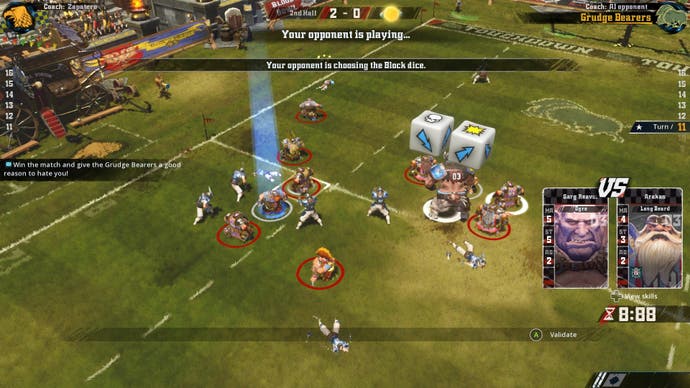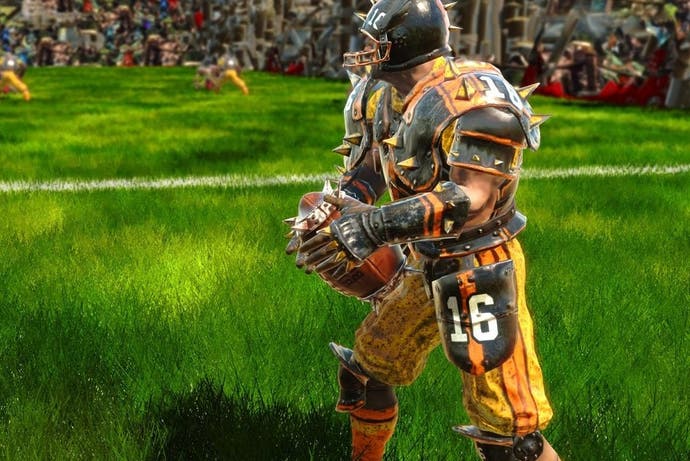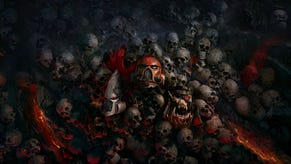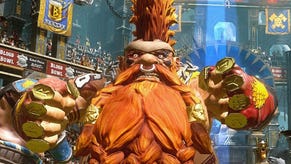Blood Bowl 2 review
Brutal deluxe.
I can't think of a game in which it's more enjoyable to lose than Blood Bowl. When you're 3-0 down inside the second half, the dice are forever against you and the chance of a consolatory touchdown seems increasingly slim, there is always a strategy you can turn to that will rekindle your appreciation for the Orwellian sporting spirit: violent conduct. Not the whiney-bitey nonsense we've seen from the likes of Suarez and Costa, more the kind of full-blooded assault demonstrated by Harald Schumacher (no relation) in the 1982 World Cup semi-final, after which the unrepentant West German goalkeeper, since dubbed the Butcher of Seville, briefly beat Hitler into second place as the most hated man in France.
Of course, being a synergy of gridiron football and turn-based fantasy wargaming, in Blood Bowl you can go one better than shoulder charge the opposition and have them stretchered from the pitch. You can roll the bones and stamp on their heads after they're down, or bundle them over the sideline and get the crowd to do your dirty work for you. It's a risky strategy to pursue, to be sure, one that might result in an even more humiliating scoreline and a sending off or two, but there are payoffs beyond the fact that you'll be taking your frustrations out on your opponent. Assuming you're successful at reducing the effectiveness of a couple of the opposition - or, even better, ending their careers prematurely - you be giving the other teams a useful advantage when they'd be lining up against replacement rookies. That is, if you're playing in a league with your closest internet chums, which is where Blood Bowl 2 shines the brightest, with it's customisable ladders, knockout competitions and transfer windows. If however you're playing the campaign (which, as a newcomer, you likely will be), you might instead lash out purely to offset the perpetually annoying and deeply unfunny commentary.

With its crass cultural cross-referencing and nose-picking humour, the lines of your studio hosts, Jim and Bob, wouldn't be quite so insufferable if they weren't so repetitive and poorly cued. If you thought an arrow to the knee was overdone in Skyrim, just wait until you've been served the line about halflings on a sandwich for the third time in a row. The best that be said of the vocal work is that technically it's an improvement on the original game, but if it wasn't for the odd audio levels in some parts of a match - birdsong over a mass of visibly fervent fans, for example - you'd likely turn the speech right down and never bother with it again.
To be fair the campaign punditry does a fair job of stringing together what is essentially a series of cleverly-devised tutorial matches, but beyond the story of a team being bought back from the brink, it's rather a ham-fisted and boorish fantasy retelling of The Mighty Ducks. By the end of it you'll know the depths of despair only Emilio Estevez has plummeted.
Get through it, or more likely avoid it once you've got the gist of things, and the game comes into its own. The single-player AI, which for large parts of the campaign seems heavily scripted in your favour, is more dynamic once the stabilisers are taken off, with opposing teams taking better advantage of the traits that define the eight core races on which you can base your teams, with the agile elves and fragile Skaven making dashing runs through carefully-arranged tackle zones, while dwarven and chaos teams huddle around the possessing player to steamroll the opposition with their strength and armour values.
While much improved on the efforts of the original Blood Bowl, the AI is far from brilliant. For veterans of the tabletop game the flaws will be all-too obvious, with the AI given to prioritising its moves in rather odd ways, seemingly more intent on advancing its own line or breaking a receiving player through yours than in actually getting the ball forward. More telling is that the AI seems oblivious of the scoreline, or how many turns remain in the match, setting itself up for a touchdown that will require more turns to complete than are available. Human players will do this too, of course, just not so consistently.

One thing that the AI will never do is give up: It was a problem that occasionally dogged the original game and looks to be one that is continuing with the sequel, that some players would rather crash out of a multiplayer match than lose it, which can be deeply frustrating when after 30 minutes of carefully poised plays and turnover-avoidance, your opponent bugs out and the rewards for a win are cruelly denied you. In my first online match my cause was lost by the end of the first half, but even 2-0 down and with a player slain, I carried on, naturally more focused on drawing blood than scoring goals. Alas I didn't manage to fatally wound any of the opposing team, but it was telling that in the final turn its manager thanked me first for not bailing out before congratulating me on what was a genuinely good game.
And that's the thing, ultimately. For in spite of the AI being unable to put up any stiff competition, and for some weasley humans to not put up any competition at all, and against the clumsy audio, the limited camera options and the game lacking the racial diversity of Blood Bowl 1's Chaos Edition, Cyanide's sequel is still worth a punt. Because despite the development team's past ability to fumble the ball, now at long last the essence of what makes the source material such a compelling celebration of randomness and asymmetrical team-building is allowed to shine through. Where in the original 2009 release the UI was a mess and the core game lost under a pile of scrappy single-player modes, there is a slickness to proceedings and a comprehensiveness to the campaign that makes Blood Bowl 2 approachable and the multiplayer game an attractive and necessary option - rather than the only one that's serviceable.
It's not quite top of the table yet. It needs more multiplayer and camera options, sound tweaks, a lobby system, a few more stadia, crowd diversity and a bunch more teams to bring it closer to the 23 available in previous editions , but it's already a better game than its predecessor, considerably so if you were one of those to have been lumbered with the console variant. I can't promise you won't be frustrated again, but at least with Blood Bowl 2 any need for retribution will largely be down to the quality of the opposition rather than the game itself, against which a sound kicking will do wonders for your constitution.













